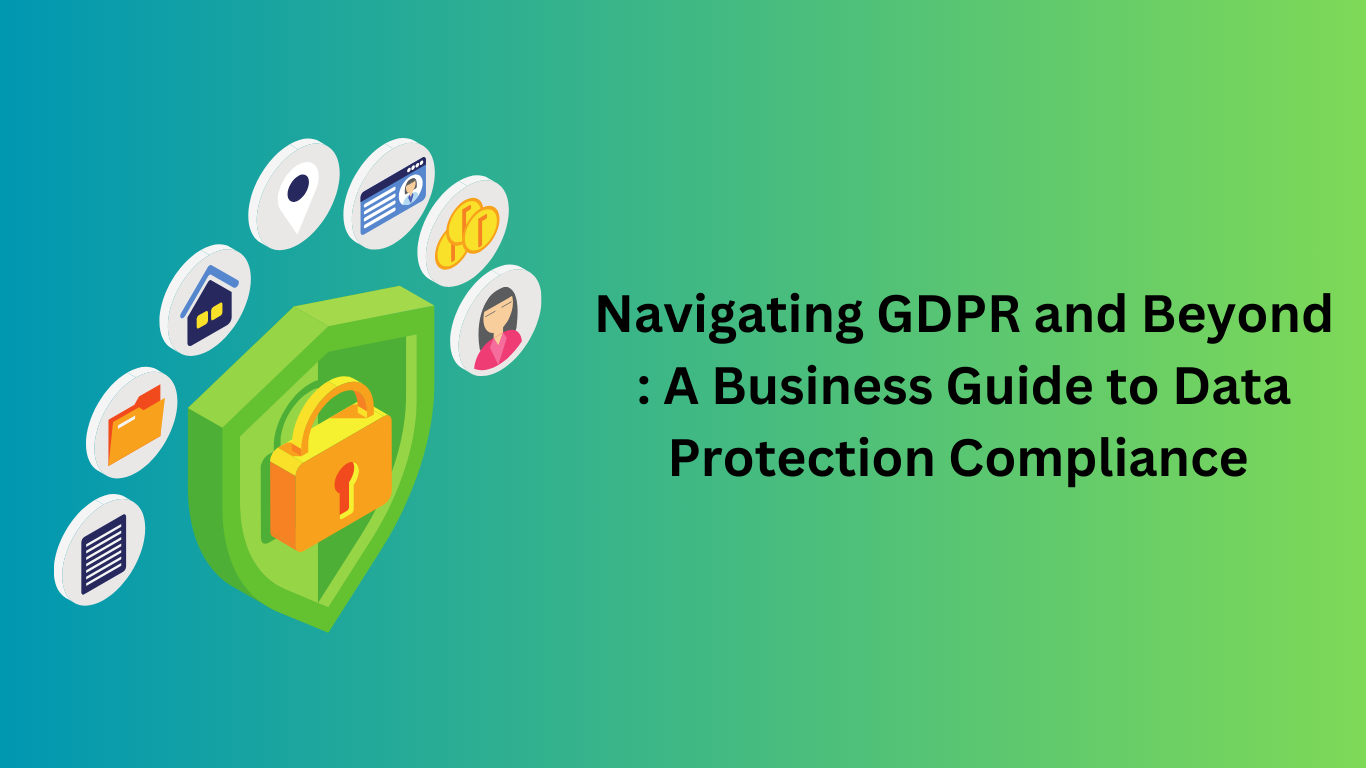In this fast-evolving digital world, data is one of the most valuable assets that a business owns. Customer information, business strategies, or proprietary technology is the basis for how organizations operate and grow. But with the more extensive use of data, more attention and regulation also come along. This has made data protection a top-of-mind issue for businesses anywhere in the world. At the top of these is the General Data Protection Regulation, an omnibus data privacy and security law promulgated by the European Union in May 2018. But there are still other international and national laws concerning data protection aside from this. The legal trends are also changing with time.
This article will try to outline key principles, requirements, as well as best practices for ensuring data security and protecting customer privacy by guiding businesses on how to navigate compliance with GDPR and other data protection regulations.
What is GDPR?
The GDPR are regulations that have been developed to mainly protect the personal data and privacy of the citizens of the European Union. All the organizations around the world will have to follow this regulation if they are processing or handling the personal data of people living in the European Union. Therefore, it is a step toward transparency and accountability and holds importance to the needy people who deserve rights over their own information.
Now, let’s move toward some of the key elements of GDPR:
Key elements of the GDPR:
- Protection by Design and by Default: The organizations should ensure that data protection measures are built in from the design of any data processing project that involves personal data. It therefore includes the implementation of appropriate technical and organizational measures for protecting personal data from its creation until disposal.
- Consent: Organizations should obtain clear and unambiguous consent from a person before the actual obtaining of the personal data of that person. It must be given by the individual, and the consent must be given intelligently; it has to be specific and it should be unambiguous. It can even be withdrawn anytime.
- Rights of the Data Subject: In this regard, under GDPR, rights have been provided to a data subject about his data, which include rights of access, rectification, erasure, or restriction of processing of personal data. The regulation continues to be innovative by attaching the data portability rights; thus, a data subject has the right of obtaining his data in a structured, commonly used format that is compatible with the service provider offering that to another service provider.
- Accountability and Records: Organizations shall maintain records regarding processing activities, including:
Documents on the purposes for which data are processed, Categories of data processed, and Technical and organizational measures.
- Notifying a Personal Data Breach: An organization involved shall inform the relevant supervisory authority of a Member State within 72 hours after having obtained knowledge of a breach. If the personal data breach is likely to have an impact on the individual to such an extent that it causes harm, such as fraud, deception, or identity theft, he/she must also be informed accordingly.
- Data Protection Officers (DPO): An organization dealing with substantial amounts of sensitive data or systematically monitoring large sets of people should designate a Data Protection Officer to serve as a compliance officer.
- Cross-Border Data Transfers: By and large, GDPR bars cross-border transfers of personal data unless based on suitable measures such as the EU-US Privacy Shield or SCCs.
Important Steps in Achieving GDPR Compliance
GDPR is indeed an organized and intimidating task for businesses. In fact, if an appropriately well-structured approach is maintained, organizations can have measures in compliance and conveniently reduce the risk of suffering from a violation of data protection. Provided below are some of the most basic steps that will help businesses get started with GDPR compliance:
- Data Audit It is actually a good starting point toward compliance to know what personal data your organization holds and you use it. So, carry out a data audit that reveals all the collected data, where it is, how it is processed, and to whom it is accessible. This also discovers gaps in the data protection practices of your organization.
- Update and review privacy policies. A clear privacy policy has been one of the great aspects of complying with GDPR. It should elucidate the purposes for processing, rights of the data subjects, and mechanisms for withdrawal by which the organization collects, stores, and processes personal data. Your privacy policy ought to be up-to-date and very easy to understand for customers.
- Data Protection Measures After identifying what data exists and how the business uses the same, you then adopt appropriate measures of protecting the data in place. These include data encryption, access controls, proper storage of data methods, and so forth. Businesses also ensure that transmitted data over such communication is secure, for example, communication protocols like HTTPS.
- Employee Training Educate all employees about the principles of data protection and the obligations of the organization under GDPR. Conduct training and create a culture in an organization where privacy awareness reduces the risk potential due to human error.
- Preparation of a Data Breach Response Plan a business, therefore, should prepare for data breaches by having a clear plan to deal with such eventualities. Such procedures include those that will identify and contain the breach, report it to the appropriate authorities as well as all those affected, and communicate to stakeholders about this breach. This process will ensure swift and effective responses in case of such a breach.
- Consent Valid to the extent that the personal data you collect comprises data collected from people, ensure that consent to collect this data was valid. This is essentially through clear consent forms such that people will be able to know their ability to have their data used or not. No pre-ticked boxes or vague statements, which offend GDPR.
- Continuous Compliance the compliance under GDPR is not a one-off activity; it has to be maintained continuously. Organizations have to check upon their internal data protection practices, and then the policies and procedures need an update if something is wrong. Many of the regulations require risk assessments and internal audits before compliance.
Key Global Data Protection Regulations and Compliance:
Although GDPR is probably one of the most stringent data protection regulations existing worldwide, other jurisdictions have enacted similar laws to which businesses need to conform as a result of where they may operate. Some of the key regulations include:
- The California Consumer Privacy Act (CCPA): The CCPA is California’s privacy law that will protect the personal data of California’s residents. It is surprisingly very close to GDPR in arming consumers with powers to access, delete, and opt out of selling their personal information. Businesses are placed under obligation under CCPA only if they have exceeded specific thresholds in terms of revenue and number of consumers whose data is processed.
- Health Insurance Portability and Accountability Act: HIPPA applies to any organization in the United States that is running its business in the health industry to establish standards on protecting sensitive information about a patient. It further demands more based on data security because health-related data is accessed only by authorized entities.
- The Personal Data Protection Act (PDPA): It is Singaporean legislation that seeks to surpass data protection obligations for organizations within the country. In all these provisions, the PDPA does insist on the importance of consent in collecting personal data and insists on requiring the rights and control of the person over their personal information.
- The General Data Protection Law (LGPD): LGPD in Brazil is another regulation comparable with the GDPR and applies to organizations conducting operations in Brazil or processing the information of Brazilian residents. The legal explanation on gathering, using, and holding personal data also clearly gives rights to the individual identical to those provisions in the GDPR in the EU.
Conclusion on the Future of Data Protection and Compliance
Data protection policies are unfolding as technology advances the digital landscape. Companies need to keep up with data privacy law changes recently made in order to stay abreast of things. Governments around the world are beginning to take personal information seriously, thus yet another area companies must review their strategy on: artificial intelligence, which is extremely popular nowadays, the Internet of Things, and increased use of big data.
Then the organization must turn active from reactive regarding data protection. That means, in addition to complying with the existing regime, organizations will also learn ahead of the requirements and apply privacy considerations to every aspect of the business.
Conclusion
Navigation of GDPR as well as other data protection regulations might be a little trying, but that is what it takes to be compliant with the law in building trust from customers while avoiding a potential fine. The very basic requirement of knowing to have the right data protection practice and keeping in awareness of the constant flow of regulations can keep personal data safe and enhance a company’s reputation by aversion from potential legal pitfalls. The right approach to data protection turns it into a new, different competitive advantage for making the customers, partners, and shareholders gain confidence.


